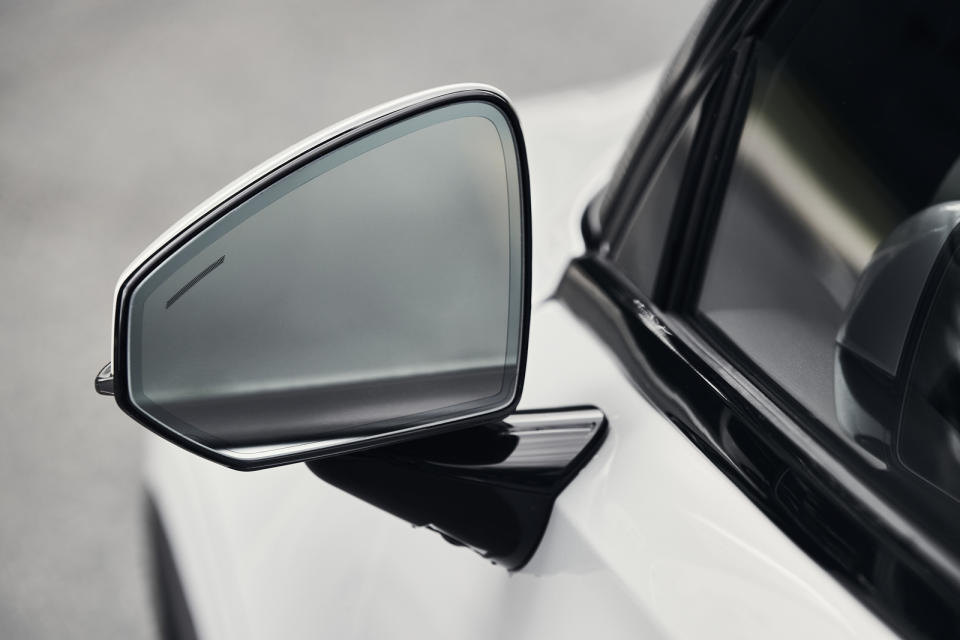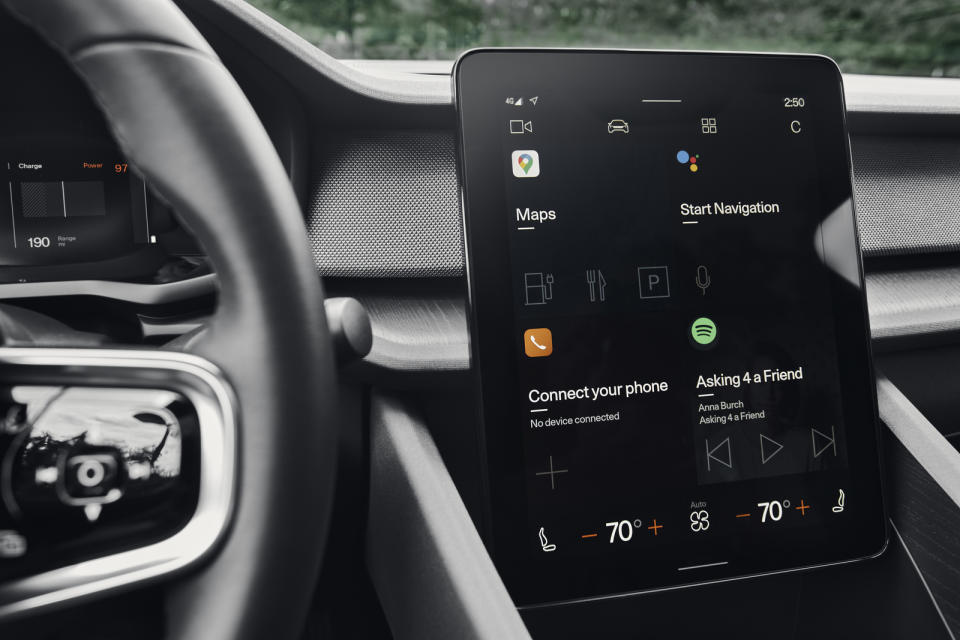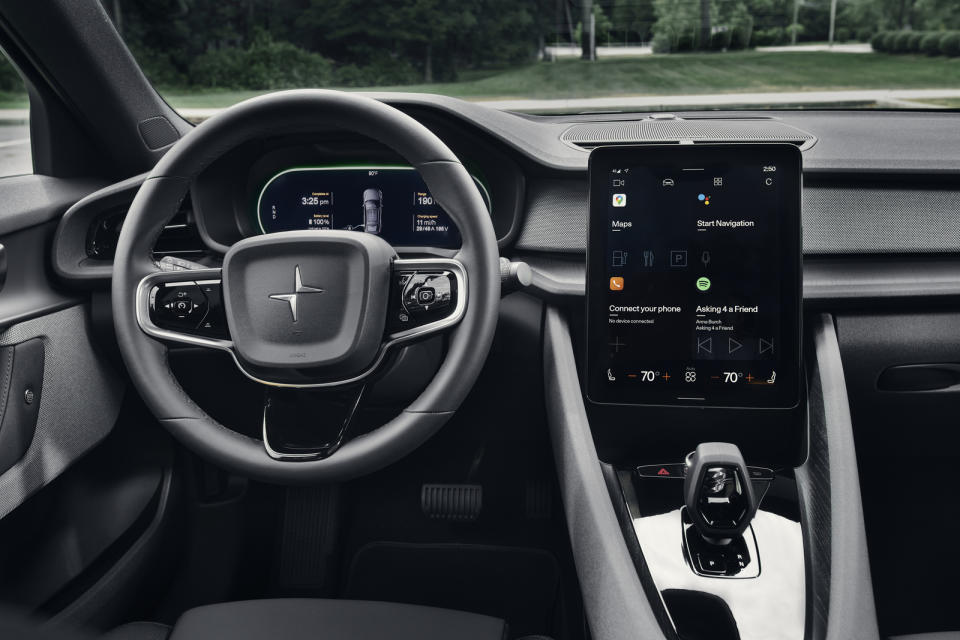Polestar 2 first drive: a sporty EV with Android Automotive inside
408 electrified horses can't be wrong.
A little more than a year after its live streamed debut at the 2019 Geneva Auto Show, the Polestar 2 is finally ready to hit the streets. Engadget took the $60,000 premium electric vehicle for a drive this week to see how this EV fastback handles the challenging curves of the Santa Cruz hills.
The five-door Polestar 2 is outfitted with a 78kWh reinforced battery pack that delivers power to a pair of motors -- one each over the front and rear axles -- to produce 408 hp and 487 ft-pounds of torque with a range of 291 miles. However, if you opt for the $5,000 Performance pack that upgrades the suspension and brakes, along with 20-inch aluminum rims (instead of 19s) and gold-colored seat belts, the mileage will decrease noticeably. During my test drive in the Performance model, I started with a reported range of 210 miles at 100 percent battery charge. Even without the added performance though, the Polestar 2 can hit 60 mph from a standstill in 4.45 seconds, do a quarter-mile in 12.76, and tops out at just over 125 (electronically limited) mph.
Cargo capacity is at a premium inside the vehicle, with just 15.5 cubic feet of storage space unless you fold the rear seats down. That said, if you’re looking to haul groceries rather than a whole lot of ass, this might not be the EV for you. You might instead consider the Hyundai Kona Electric or Kia Niro EV, because this EV is certainly not an electric SUV.
The Polestar 2 was a blast to drive through the twists and turns of CA-35. Thanks to the electric motors’ instant access to torque, a mere flick of the gas pedal at the apex of a curve had me blasting out of it faster than when I entered. That quick acceleration was apparent in normal city driving both in the relative bustle of midmorning downtown San Francisco and the sleepy, sweltering sprawl of suburban Los Gatos. The one-pedal driving system proved to be pretty useful in light city traffic, enabling me to automatically slow to a crawl simply by lifting my foot off the gas. That feature can be turned off if you prefer a two-pedal driving experience. I had no trouble keeping up with traffic either on city streets, multilane boulevards or at freeway speeds. Especially at freeway speeds. It easily kept pace with the flow of traffic — even when that flow might have exceeded the posted speed limit.

Your biggest concern will be making sure that the lane next to you is clear when you do try to pass because the Polestar 2’s blindspots are big enough to hide a MAC truck in. The A-pillars are broad, as are B-pillars. Plus, the side mirrors have been minimized to lower the drag coefficient, but they only give you a tiny peek at what’s in the lane next to you. I’d gladly take the reduced range if it meant I could get a better look at the traffic around me from larger mirrors.
The centerpiece of the Polestar 2 is the vehicle’s fancy center console. It replaces virtually every knob, dial and switch with an 11-inch screen running one of the first versions of Android Automotive OS available to third-parties. Aside from the window and mirror controls, door locks and gear shift, everything is run through what looks like an iPad Pro set in portrait mode and crammed against the front of the dash. I’ve never been much of a fan of these sorts of controls. The idea of hunting through multiple sub-menus on a glorified tablet while navigating rush hour traffic has always given me the heebie-jeebies, but the AAOS system is remarkably straightforward and intuitive. I never tapped more than a couple times to get to the control I was looking for.

That’s not to say there isn’t a learning curve. I spent 10 sweltering minutes in 98 degrees weather trying to turn on the A/C for the first time but after that, the process took seconds. And to be fair, I could have just not been stubborn and said, “Hey Google, turn on the air conditioning and set the temperature to 68 degrees.” Because that works too and it’s pretty cool.
Typically when you pair your smartphone to your car’s infotainment system, it simply mirrors the phone’s functionality. AAOS, on the other hand, is a standalone system meaning you won’t have to physically plug your phone into it -- though you will need a Bluetooth connection to make calls and send texts.
Instead, you simply link the infotainment to your Google account. Doing so enables a deeper degree of integration, enabling drivers to use their preferred options when dealing with Maps for navigation, Google Play for media or Assistant for voice assist. What’s more, according to the Polestar press kit, if you’ve already own a Google Home, congrats, your Google account already has a bunch of recordings of your speech patterns so the infotainment system will more clearly understand you from the get-go.
“From a security perspective, similar things that we have on the phone are things that also exist in the vehicle,” Haris Ramic, Google product lead for Android Automotive, told Engadget. “So for example, you can go set it up, if you lock your account, it gets encrypted. And [to access that encrypted data] you have to either enter a PIN into the vehicle or sometimes to do something on the phone [such as 2-factor authentication] to open it up. When the vehicle does shut down, the user partitions, which is the area where all the user information is stored, also get encrypted.”
What’s more, Google is being cautious as to which companies are being allowed access to its fledgling OS’ APIs. “The goal is, obviously, not to focus just on big companies because innovation can come from anywhere. We don't want to provide a set of API's that anybody can use,” Ramic continued. “But partially the reason why we're going so slow is, rather than just opening up everything and saying anybody can develop anything they want, we're targeting areas where we know there's a lot of consumer value.”
Logging in to the infotainment system is not a requirement, mind you, it will work just fine without your credentials, just not with the same degree of personalization (and data privacy exposure) as if you did. During my test drive, I used a generic account provided by Polestar and paired my phone via Bluetooth. So while it wouldn’t play songs from my Google Music account, I still had easy access Maps, Assistant and Spotify.

Assistant was surprisingly effective and intelligent during the four-plus hours I had to play with it. I didn’t have to manually input any destinations, simply told Assistant where I wanted to go and the system automatically generated a route. This was way, way easier than the navigation experience we saw with the Cooper SE back in January. Assistant was generally unfazed by background noise, quickly responding over the sounds coming from the Polestar’s 16 speaker Harmon Kardon stereo system and really only got bogged down when trying to understand me while I shouted commands with the windows down at freeway speeds.
It did return a few incorrect results when I asked it to play specific bands. For example, when asked it to play The Coup, Spotify loaded up “In the Coupe” by Curren$y and Harry Fraud instead, or when I requested Chika, I got Chica. And yet somehow when I asked for Fear and Loathing in Las Vegas, the system correctly loaded “Return to Zero“ without hesitation. Whether that’s a shortcoming of Assistant’s ability to parse language or Spotify simply not having those artists in its catalog is something I couldn’t discern during the few hours I had the car. But it definitely made me long to have access to my existing Google Music playlists.
One issue I did run into was the fact that streaming media requires a 4G/LTE connection and when picking my way through the Santa Cruz hills, I often ran into service dead zones which would cut the music until the signal was restored (thankfully, it didn’t impact navigation.) This goes for streaming services like Google Music or Spotify as well as FM and AM radio stations (which are also streamed via an onboard app because AM radio signals play havoc with EVs.) Luckily you can easily get around this issue by making a hard connection between your phone and the system via one of four USB-C ports and playing media directly from the phone’s hard drive if you don’t want to chance it. The console also offers a 15w charging pad for induction-capable phones.
Volvo’s influence (as part-owner of the brand) is apparent in the vehicle’s broad array of safety and driver assist features. It will feature Level 2 ADAS, namely Pilot Assist (which is already being deployed in Volvo models like the V60 and the XC90) -- it provides acceleration, braking and steering up to 81 mph; blindspot, rear crash, and cross-traffic alerts; a lane-keeping aid, crash mitigation and avoidance. It even keeps an eye on the driver to make sure they’re staying focused on the road. That’s not to say it has cameras monitoring the driver or anything, the attention monitor is based on steering wheel contact. One unique safety feature of the Polestar 2 is its front inner-side airbags. These are mounted on either side of the center console and are designed to protect both driver and passenger from either shattering their femurs against the console or slamming into one another in the event that the vehicle gets hit from the side.
The car’s body is constructed from stamped steel with five paint options and a pair of interiors made from vegan materials, but if you want the Napa leather, it’s available for four grand extra. Why you’d spend that, I have no idea. The standard Weavetech seats are made from cork and recycled plastics (sans the phthalates which typically are used to increase material flexibility) and are very comfortable. The seat upholstery looks like leather but breathes like cotton -- even in triple-digit temperatures my backside remained dry.
Polestar is already working on three OTA updates for the coming months: a digital key similar to what we saw from Apple and BMW in July. That’s arriving later this year, as is a “connected safety” feature. Apple CarPlay compatibility should be ready by early 2021. If you’ve already got a preorder registered with Polestar, the first batch of vehicle deliveries should start arriving in September. Unfortunately, if you put down a deposit today, you’re looking at a December delivery date. Unusually spec’d orders (that is, color, interior and package combinations that not many people are asking for) are looking at a potentially similar time lag.

